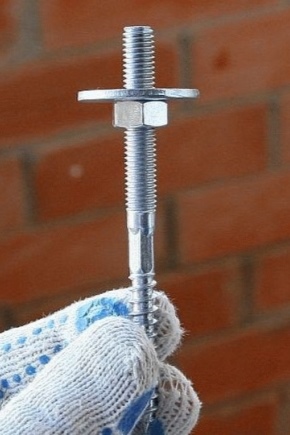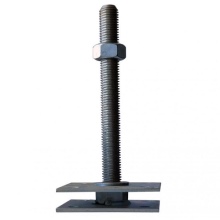All about adjusting anchors

Adjusting anchors are indispensable elements of the stop that allow you to compensate for the shrinkage of timber and other natural timber lumber. Their types and sizes are quite diverse, making it possible to determine the appropriate option for the installation of temporary and permanent structures. The use of anchor bolts for timber, for a height-adjustable floor can be a good solution if you need to shrink the material without risking the entire building.

Peculiarities
An adjustable anchor is a metal product with a prefabricated structure. It contains a support and a counterpart, a threaded sleeve and fasteners screwed into it. To compensate for shrinkage, it is enough to simply change the adjusting anchor in height, increasing or decreasing it. The supporting parts of the plates have holes in their design, with the help of which they are fastened to the surface of wooden structures. Sometimes there are guiding tubular elements in the reciprocal platform.
The basic rule for choosing an adjusting anchor is as follows: its support platforms should correspond in size to the section of the log or timber that they have to hold. The principle of operation of the shrinkage compensator is quite simple. It is installed strictly on those areas that were planned during the design, under the post or support beam, with the attachment of the counterpart to the floor joists, the roof structure, and other load-bearing element of the building or structure.
The manufacture of this type of hardware is carried out from alloy or carbon steel. Hot-applied zinc coating is used to protect against corrosion. The stud and nut are of a standard design with a fairly wide pitch. By moving the locking element, it is possible to reduce the gap between the plates.
The connection is considered detachable - it can be dismantled from the structure at the end of the shrinkage process.






Applications
The main purpose of using adjustable anchors is preservation of the specified geometric parameters of a wooden structure after its shrinkage... The installation of a spacer element makes it possible to eliminate distortions that arise when the moisture content of the log and timber changes. The wood does not crack under pressure, there are no deformation changes manifested in the warping of frames, doorways, the formation of cracks and gaps. Average shrinkage can reach 50-150 mm, and sometimes it reaches 300 mm, therefore, the use of shrinkage compensators is almost mandatory in the construction of houses and baths from a bar, logs.
Adjustment anchors are most in demand when assembling frames of buildings and structures, installing support pillars, columns, rafter systems... For both the bar and the round log, square-base platforms are used. This measure is especially relevant during the first 3 years after the construction of the facility.
It is during this period that natural wood continues to lose its natural moisture accumulated over the years of its growth.


The joints and stiffeners are the most vulnerable to deformation loads. This is important for the floor, for the lag of the roof structure, pillars and columns on which the walls of the building rest. In some cases, the use of a hammer-in brass collet and a steel stud is possible even without plates. For example, when installing adjustable floors over a concrete base, it is enough to simply place the collet in the monolith, and the threaded element in the log.
Adjustable floors and rafter systems are well suited for seasonal use. Sheet materials are used as flooring on adjustable floors - most often, thick plywood of at least 18 mm for a single-layer installation and from 12 mm when using a double structure.
Of course, special anchors in such structures are more appropriate, but due to their high cost, they are often replaced with adjusting counterparts.


What are they?
The anchor bolt, with which the adjustment and shrinkage compensation is carried out, is not very diverse in design. Hardware can be standard and atypical, made to order. Basic options do not exceed 150 mm in length and have a size range from M20 to M30. All atypical diameters and dimensional characteristics of materials are most often made to order.
By the type of their design, adjusting anchors are most often driven in. They involve the use of a brass stainless steel sleeve installed in a pre-drilled hole.
The stud can be galvanized, carbon steel or alloy steel.



Dimensions (edit)
The size range of the adjusting anchors is quite wide. It includes standard products - their height is limited to a range of 10-15 cm. Larger versions have an increased diameter of the screw itself - at least 30 mm. Their height can reach 300 mm, products are installed on support platforms of increased thickness - up to 10 mm and dimensions (at least 150x150 mm). Such a support easily copes with load compensation in thick logs or large timber.
The standard diameters of adjusting anchors also include indicators of 15 mm, 20 mm, 24 mm. This parameter corresponds to the external dimensions of the threads. It is on them that they are guided when you need to prepare a hole for installing fasteners. In addition to the cross-section of the stud, the dimensions of the supporting elements are important. The more pressure the hardware experiences during operation, the larger it should be. The standard size range varies from 10x10 to 25x25 cm with a thickness of 6 mm.

Installation
The installation procedure for the adjusting anchors is quite simple. The product is selected according to the size of the base, its support platform and counterpart are equipped with suitable fasteners. Let's consider the further procedure.
- Beam / log trimming with a feather drill... It takes into account the length of the screw. Then you can install the plate.
- The counterpart is attached to the base of the building, most often to the concrete foundation, using an anchor... Drilling is also done beforehand.
- An elevator stud with a nut is installed. To begin with, it is turned inside out to its full length. Then they are installed on the end or horizontal lag, foundation. It is worth considering that the location of the expansion joint is not very important, but for the convenience of subsequent adjustment, installation is usually performed from the bottom of the support.
- With the help of a lifting mechanism, the vertical support is pushed onto the regulator. It is optimal to fix the structure in the upper third of the stud, and then adjust the size of the clearance with a nut. For the period when no change in height is required, it is recommended to use a decorative cover.
- Change in lift height... During the period of active shrinkage of the building, it is required at intervals of 1 time in 3-6 months. The average time required to change the support height is no more than 15 minutes.



Installation of adjusting anchors is carried out exclusively in compliance with safety regulations. A prerequisite is the participation of at least 2 workers in this procedure. This prevents accidental collapse of the structure and prevents injury. During the construction phase, installation should be carried out exclusively by a group of workers, with insurance of all elements.
You can find out how the adjusting anchor works in the video below.













The comment was sent successfully.